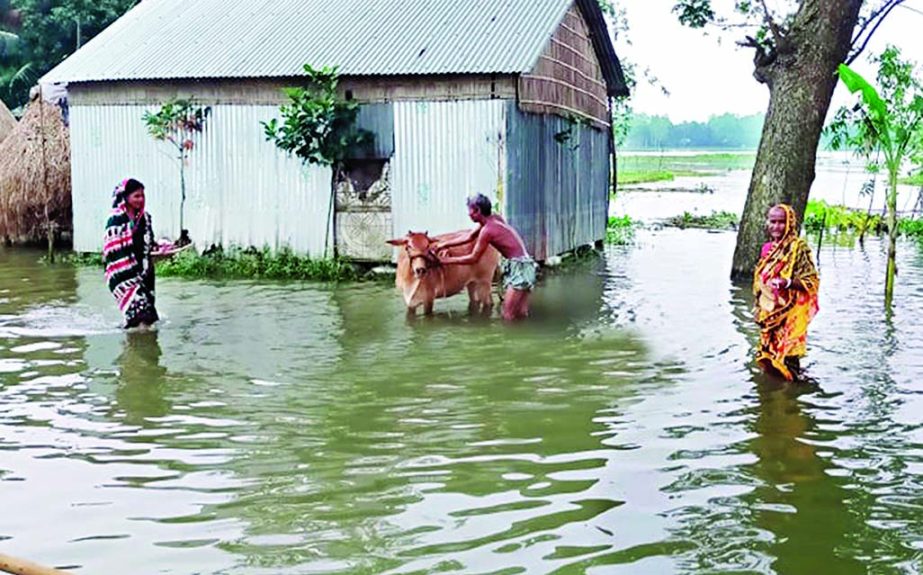
News Desk :
The ongoing flood, caused by incessant rain and onrush of water from upstream rivers, has marooned 1.1 million people in 14 districts in the last one week.
Most of the flood-hit people are in need of emergency aid, said representatives of local government bodies.
A total of 1.105 million people were marooned at 260 unions in Nilphamari, Lalmonirhat, Kurigram, Rangpur, Gaibandha, Sirajganj, Bogura, Tangail, Jamalpur, Rajbari, Manikganj, Madaripur, Sunamganj and Sylhet districts, according to the National Disaster Response Coordination Centre (NDRCC).
Jamalpur, Sunamganj, Tangail, Sirajganj, Gaibandha and Kurigram are the most affected districts during the one and half weeks long flood.
The Flood Forecasting and Warning Centre (FFWC) recorded that nine major rivers swelled over their respective danger levels at 17 points in the country on Saturday. It forecasted that water might decline in the Teesta, Brahmaputra, Meghna basins.
Water level rose at 61 points and declined at 39 points on Saturday.
According to Bangladesh Water Development Board (BWDB), water levels of the Brahmaputra marked fall by 17cm each at Noonkhawa and Chilmari, while the Jamuna by 14cm at Fulchhari, 15cm at Bahadurabad and 9cm each at Sariakandi and Kazipur and 11cm at Sirajganj points during the last 24 hours.
But the Brahmaputra was flowing 24cm above the DMs at Noonkhawa and 29cm at Chilmari and Jamuna 56cm at Fulchhari, 59cm at Bahadurabad, 51cm at Sariakandi, 55cm at Kazipur and 35cm at Sirajganj points at 9am on Saturday.
The water levels of the Dharla and Teesta rose by 11cm and 36cm at Kurigram and Dalia points in Nilphamari during the period and were flowing above their DMs by 60 cm and 18 cm respectively at 9am.
The Teesta Barrage has opened all 44 sluice gates to control the floodwaters, and consequently, inundating low-lying areas in Dimla and Jaldhaka upazila of Nilphamari and more families affected by the flood.
WDB Deputy Assistant Engineer (Water Branch) Aminur Rashid said, “Low-lying and char areas in the Teesta River basin were inundated due to heavy rains and onrush of water coming down from India. The Teesta Barrage has opened all 44 sluice gates to control the floodwaters.”
The Ghaghot marked a fall by 4cm during the last 24 hours at Gaibandha where the river was flowing above its DM by 27cm at 9am on Saturday.
Executive Engineer of BWDB Mokhlesur Rahman for Gaibandha said all flood control embankments and structures are safe and riverbank protection works continuing at few places in the district.
BWDB’s Executive Engineer Ariful Islam for Kurigram said water levels of the Dharla might start receding in the next 24 hours and the Brahmaputra continued receding to improve the flood situation.
Chief Engineer for Rangpur Zone of BWDB Jyoti Prosad Ghosh said the flood situation is likely to continue improving in Lalmonirhat, Nilphamari, Kurigram, Gaibandha and adjoining areas in the next 24 hours.
“There is no report of any vulnerability of flood control embankments and we are closely monitoring the situation and safety of flood control structures,” Ghosh added.
He said the government has been continuing to carry out relief activities as the current deluge exposed thousands of people to miseries following the inundation of vast low-lying areas in the affected districts in the basin.
District Relief and Rehabilitation Officer (DRRO), Kurigram Dilip Kumar Saha said 302 tons of rice and Tk 36.5 lakh allocated by the government are being distributed among 122,000 flood-hit people of the district.
Gaibandha DRRO Mokhlesur Rahman said distribution of 200 tons of rice and Tk13 lakh continues among 325,000 flood-affected people of 26 unions in four upazilas of the district.
Dimla Upazila Nirbahi Officer Joyoshree Rani Roy said distribution of 125 tons of rice and Tk 1.5 lakh continues among 3,200 affected people and 69 river erosion-hit families of Dimla upazila in Nilphamari district.
Besides, the overall flood situation in Jamalpur and Tangail remained unchanged and was yet to improve despite the steady drop in the water level of the Jamuna, and Jhenai rivers.
In Jamalpur, the Jamuna River dropped by 17cm and was flowing 57cm above the danger mark at Bahadurabad Ghat point for the last 24 hours until 12pm on Saturday, said the Water Development Board (WDB).
Department of Agriculture Extension Office sources said standing crops on 13,343 hectares of land have been submerged by floodwater.
District Relief and Rehabilitation Officer (DRRO) Md Nayeb Ali said even though floodwater started receding but the situation is yet to improve.
He said over 387,394 people in 49 unions of all seven upazilas of the district have been affected in the flood.
Nur Salam, chairman of Hatibhanga union in Dewangaj upazila under Jamalpur district, said nearly 0.1 million people are waterlogged in Dewanganj upazila for a week as the river Jamuna devoured localities.
He said 800 families of his union were marooned who have no food, water and other sanitation facilities during this pandemic.
Mr Salam said his union needs at least 10 tonnes of rice for each week while they got only 700 kgs so far.
He said affected people got Tk 5.0 per head in his locality when many of them lost their houses due to heavy flow of Jamuna.
Meanwhile in Tangail, even though the water level of Jamuna and Jhenai rivers have started to recede, the Dhaleshwari, Jamuna and Jhenai rivers are still flowing above the danger marks in Tangail.
According to the WDB, the Jamuna was flowing at 34 cm above the danger mark, the Jhenai river was flowing at 48cm above the danger mark and the Dhaleshwari River was flowing 90cm above the danger mark.
As a result, 124, 571 people have now become stranded in six upazilas of the district. Besides, 3,613 hectares of cropland have submerged and the overall flood situation in the district remains unchanged, said District Relief and Rehabilitation and district.

